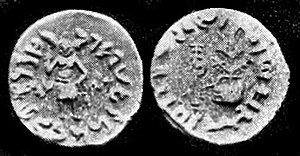Gurdaspur
This article needs additional citations for verification. (July 2012) |
This article possibly contains original research. (October 2017) |
Gurdaspur | |
|---|---|
Town | |
 Mechanical Block | |
| Coordinates: 32°02′00″N 75°24′00″E / 32.0333°N 75.40°E | |
| Country | India |
| State | Punjab |
| District | Gurdaspur |
| Area | |
| • Total | 35 km2 (14 sq mi) |
| Elevation | 241 m (791 ft) |
| Population (2011) | |
| • Total | 75,549 |
| • Density | 649/km2 (1,680/sq mi) |
| Time zone | UTC+5:30 (IST) |
| PIN | 143521 |
| Vehicle registration | PB 06 |
| Website | gurdaspur |
Gurdaspur is a town in the state of Punjab, situated in the northwest part of the Republic of India, between the rivers Beas and Raavi, 10 km from the international border between India and Pakistan. It houses the administrative headquarters of Gurdaspur District and is in the geographical centre of the district.
Gurdaspur city was named after Mahant Guriya das ji.[1] The Emperor Akbar was crowned at Kalanaur, which is 26 km from the city. Behrampur town, where the Maqbara (mausoleum) of Bairam Khan is situated, is 10 km away. Dinanagar town, which was the capital of the kingdom of Maharaja Ranjit Singh, is 12 km away.
Demographics
According to the 2011 India census,[2] Gurdaspur had a population of 2,299,026 (1,212,995 males and 1,086,031 females). There was a 9.30% increase in population compared to that of 2001. In the previous 2001 census of India, Gurdaspur District had recorded a 19.74% increase to its population compared to 1991.
The average literacy rate of Gurdaspur in 2011 was 81.10%, compared to 73.80% in 2001. The male and female literacy rates were 85.90% and 75.70%, respectively. For the 2001 census, the rates were 79.80% and 67.10% respectively. The total literate population was 1,668,339, consisting of 928,264 males and 740,075 females. Sex ratio is about 895 females per 1000 males. Population Density was 649 per square km. [2]
History

Obv: Standing figure, probably of Vishvamitra, Kharoshthi legend, around: Mahadevasa Dharaghoshasa/Odumbarisa "Great Lord King Dharaghosha/Prince of Audumabara", across: Viçvamitra "Vishvamitra".
Rev: Trident battle-axe, tree with railing, Brahmi legend identical in content to the obverse.[3]
Gurdaspur, a major city of Punjab, was founded by Guriyaji Mahant in the 17th century. The place forms the northernmost part of the state. Resting within Jalandhar division, and flanked by the rivers Beas and Ravi, it shares its boundary with the districts of Hoshiarpur, Kapurthala, Amritsar and Pathankot.
Partition of 1947
During the partition of India in 1947, the future of Gurdaspur could not be decided for many days, as the majority of the population of this district, 51.14% was Muslim (mostly from the Ahmadiyya community whose headquarters were located at Qadian in Gurdaspur District). The Radcliffe boundary awards transferred only Shakargarh Tehsil of the Gurdaspur district to Pakistan. The rest of the district was transferred to India as the Muslim majority had moved west. The Muslim population migrated to Pakistan. Many refugees, the Hindus and the Sikhs of Sialkot and Tehsil Shakargarh, migrated to Gurdaspur after crossing the Ravi bridge. They settled and spread throughout Gurdaspur district.
At the time of partition, Gurudwara Kartarpur Sahib, a famous Sikh heritage site went to Pakistan.[4]
Education
Gurdaspur has many elementary and secondary level schools and has 13 degree level and engineering colleges.[5] Beant College of Engineering & Technology Gurdaspur is among them, founded by then Chief Minister Beant Singh in 1995. A nationally accredited body by Ministry of Tourism (India) Institute of Hotel Management, Catering & Nutrition is also located in Gurdaspur.[5]
See also
References
- ^ "About District". Gurdaspur.nic.in. Retrieved March 2013.
{{cite web}}: Check date values in:|accessdate=(help) - ^ a b "Gurdaspur District Population Census 2011, Punjab literacy sex ratio and density". Census2011.co.in. Retrieved March 2013.
{{cite web}}: Check date values in:|accessdate=(help) - ^ a b Ancient India, from the earliest times to the first century, A.D by Rapson, E. J. p.154 [1]
- ^ "Gurdwara Kartarpura Sahib". Sikh Wiki. Retrieved 18 December 2016.
- ^ a b "Education Facilities in District Gurdaspur". Gurdaspur.nic.in. Retrieved March 2013.
{{cite web}}: Check date values in:|accessdate=(help)
Further reading
- Chester, Lucy P. Borders and Conflict in South Asia: The Radcliffe Boundary Commission and the Partition of Punjab. Manchester UP, 2009.
- Chisholm, Hugh, ed. (1911). . Encyclopædia Britannica. Vol. 12 (11th ed.). Cambridge University Press.
- Official website


